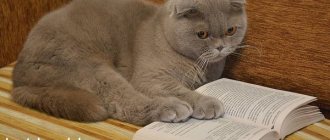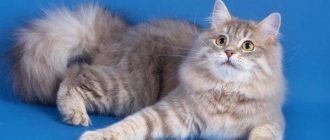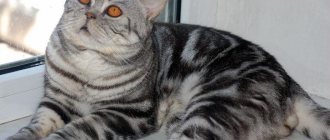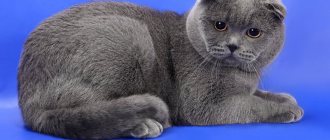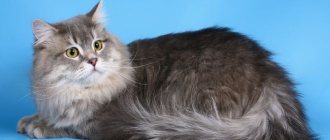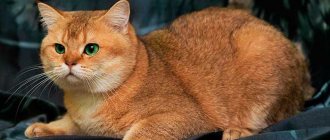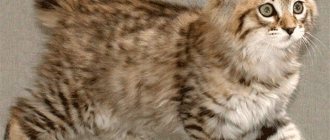The Scottish Straight or Scottish Straight is a type of Scottish breed. Translated from English, scottish straight literally sounds like “Scottish straight”. Cats are distinguished by plush fur and erect ears. Felinologists distinguish four varieties of Scottish cats: Scottish Straight, Scottish Fall, Highland Straight and Highland Fold. Highland means "semi-longhair".
In this article we will talk about the amazingly beautiful, narcissistic, intelligent and self-sufficient representatives of the Scottish Straight breed.
Purpose
One of the main reasons why cats are cut is due to matting and matting.
In this regard, the main purpose of a haircut is to relieve the animal of the unpleasant sensations that arise as a result of the skin being pulled together by matted hair. Long-haired cats suffer from this especially often, as these troubles happen very often. Once you skip brushing, the animal begins to experience noticeable discomfort and become very nervous. Moreover, blood circulation in tight skin is impaired, resulting in unbearable itching.
An equally important reason for cutting excess hair is too hot a climate, as well as an increase in room temperatures in summer and winter. It can be very difficult for animals, especially long-haired ones, to tolerate air temperatures above 35 degrees, so it is simply necessary to alleviate the pet’s condition in such cases
Another common problem with wool cats is contamination of their long fur with excrement while going to the litter box.
In this case, there can be two ways out of the situation: constantly washing the contaminated area or cutting off the hair around the anus.
In addition to the hygienic component, there is also an aesthetic aspect to cat grooming.
A properly trimmed pet looks very beautiful and well-groomed, attracting the attention of others and pleasing the eyes of its owners. In addition, intensively shedding animals also require trimming, otherwise they will literally fill the house with their hair.
But if a cat sheds too much and for a long time, you should show it to the veterinarian, since intense hair loss can be caused by a lack of vitamins or the onset of a serious illness.
Why do cats get their hair cut?
Long-haired cats need to be trimmed periodically. Some owners will object, because their pets do not participate in competitions and exhibitions. However, the opinion that only purebred cats who want to win a prize at an exhibition need a haircut is wrong. Of course, the aesthetic appearance of the cat is not the last reason for cutting, but many veterinarians advise cutting pets primarily for hygiene purposes.
Reasons for grooming cats:
- The fur of long-haired cats is difficult to care for. Cats need to be constantly brushed, but this does not always help to avoid tangles. The matted fur forms unsightly clumps. The tangles tighten the skin, causing discomfort to the cat. The animal tries to get rid of the hairball, becomes nervous, and begins to hurt.
- The only way for animals to get rid of mats and loose fur on their own is to lick it and eat it. If you do not get rid of the tangles in time, the cat will pick them off and swallow them. This is fraught with problems with the gastrointestinal tract: the stomach becomes clogged, intestinal obstruction occurs, the cat loses its appetite, and vomits. The animal may also pull out the tangles too much, causing bleeding wounds to form on the skin.
- Injured skin is an excellent place for the proliferation of bacteria, fungi, and the appearance of lichen. Your beloved pet may lose its beautiful fur or develop a dangerous inflammatory disease.
- Old cats cannot always take care of their fur and lick it. If the haircut is not done on time, tangles will form almost every week, despite the fact that the owners cut them off.
- Some long-haired cats have a rather delicate problem - feces sticking to the “panties” of their hind legs. The owners have to carefully monitor the pet so that it does not dirty the apartment.
- Some breeds of cats, for example, British Fold, Scottish, Persian, Siberian, Norwegian Forest, do not tolerate heat well. They are used to colder climates, so they need a haircut for their well-being.
Owners should take into account that the fur takes a long time to grow, so the cat will go “bald” for a long time. Also, some animals change the color of their fur, but this happens extremely rarely.
Personality of the Scottish Straight cat
The Scots are similar in character to the British. These are calm, balanced cats that are difficult to anger. However, among them there are also restless ones who are ready to chase a fly all day. But in most cases, Scottish cats prefer to snore peacefully in a secluded corner rather than rush around the apartment.
The Scottish Straight is a proud and serious cat that does not tolerate total control from its owner. Don't expect that you will allow yourself to be squeezed or held on your lap. The cat will come to you for a portion of veal tenderness whenever he wishes. It is worth noting that the Scots are by no means hermits, they simply require a little more personal space compared to representatives of other breeds and do not like it when people interfere in their cat’s affairs.
The peak activity of Scottish cats is observed in the first year of their life. Kittens are restless and playful to a fault, and adult male cats are known for their exemplary behavior and restraint.
Straits easily tolerate loneliness, but only for a short time. They will most likely even be glad that the owners left the house for a few hours and left them alone. However, prolonged separation from humans negatively affects the character of these cats. They become capricious and grumpy, and may even take revenge for the long absence of their owners. Some owners tell how their purrs suddenly begin to shit past the tray or rummage in flower pots, although they previously demonstrated exemplary behavior.
Straight-eared Scottish cats, in moments of special tenderness for their owner, turn on their soothing quiet motor and massage with their paws, burying their nose in the neck area. At the same time, it is impossible to predict in advance when a cat will bestow this mercy on a person. Moreover, they do this not with all family members, but only with those whom they love and respect. Most likely, such a favorite will be the one who feeds the “Scottish king” on time, does not scold him, allows him to sleep in the bed and does not bother him over trifles.
Scottish cats welcome strangers and guests generously - without aggression or unnecessary suspicion, but they also do not demonstrate violent delight.
Scottish Straight cats are emotionally stable animals that are not subject to mood swings. However, behavior in the style of “the most disgruntled cat in the world” occasionally slips through. In addition, representatives of the breed are characterized by amazing persistence. If they want something, they will definitely achieve it. The cat will follow the owner wherever he goes and accompany him with annoying meows.
The Scots do not try to pull the blanket over themselves when it comes to the distribution of roles between other pets. Cats are loyal to dogs, to their relatives, and to small rodents.
Representatives of the breed easily learn the rules of etiquette. They clearly understand that wallpaper and sofa upholstery cannot be torn if the owner has forbidden it, and they feel a person’s dissatisfaction subtly. Cats are quite stress-resistant and quickly cope with changes in environment.
Many Scots are extremely passive. They prefer to watch what is happening from the side, for example, sitting on a sunny windowsill. Sometimes it seems that they are immersed in their thoughts and do not notice what is happening under their noses.
Favorite toy: feather teaser. Cats can chase such a treasure for hours.
Interesting. Scottish cats need tactile contact with a person, but at the same time they do not like to be picked up.
Training and education
There are almost no problems with raising Scottish cats. It is not difficult to accustom a Straight to a scratching post and a tray; the main thing is to start from infancy and act gently but persistently. Often, it is enough to take the baby to the tray several times for him to understand where to relieve his physiological needs. If your kitten makes a puddle on the floor, take a piece of toilet paper and place it in the litter tray. The baby will smell his own urine and understand where to go.
You can’t poke a prankster into a puddle, much less beat him. This behavior of the owner will cause aggression and a desire to do mischief out of spite. But this kitten will hide safely.
Experts do not advise training straights, they do not like it, especially since unquestioning obedience is not in their character. Show-class individuals can master the training program. In the future, they will be able to demonstrate their skills at exhibitions.
If a cat violates the boundaries of what is permitted, stop it with the command “No!” Say it in a loud and stern voice.
If the baby does not obey, lift him by the withers and imitate a cat hissing. The kitten will understand this language faster.
If your pet tries to steal food from the stove or table, clap your hands loudly to scare it away.
If your cat gets into the habit of digging in pots or chewing flowers, spray him with water from a spray bottle.
Don't scold or praise your pet after the fact. Despite his developed intelligence, he is not able to connect yesterday's exemplary behavior and today's encouragement.
Nail care
It is recommended to check the condition of the animal’s claws once every 3-4 weeks. If you have a scratching post, you don’t need to trim them - the cat is able to take care of it on its own and grinds down its claws with great pleasure, but at the same time maintains them in combat readiness - the Scottish Fold scratches very deeply and furiously.
If it becomes necessary to trim the claws, then first each claw must be looked at in the light - they contain a blood vessel.
If this vessel is caught while trimming claws, there will be a lot of blood in the house - both the cat's and the owner's - it is a rare animal that calmly takes such an incident.
In general, Scottish Fold cats are very calm about the manipulations carried out on them and rarely express dissatisfaction if everything is done correctly. Combing the fur may even end with a grateful purr from the cat or a stream of affection towards the person who performed the procedure.
An important detail is also the trimming of the tassels on the animal's ears - this must be done when examining the ears, especially if the cat will be exhibited
Character
Scottish Straights are distinguished by their flexible character. They are very smart and not aggressive. Cats quickly become attached to the house and to their owners, having chosen one favorite. They do not like to be left alone and, if possible, are not averse to jumping into a person’s arms. At the same time, they will not impose their company if they see that the owner is not inclined to communicate.
New people in the house do not scare them, although sometimes cats want to be sad alone, then they climb into a quiet place. The voice of the Scottish Straight can not be heard often, they do not hysteria, do not meow loudly, except when begging for a treat.
The owner does not have to worry about the safety of the furniture and the cleanliness of the carpet: “Scottish dogs” are very clean and polite, they quickly get used to the tray and scratching post and indifferently walk past the soft sofa without putting their claws into it.
Straight-eared “Scots” easily get along with children and other animals, without showing any aggression or jealousy. They easily tolerate moving, changing home, familiar surroundings, and if due to circumstances they are forced to change owners, they quickly adapt to the new environment.
In a word, cats of this breed can be called ideal. The main thing is that there is food in the bowl and favorite toys on the rug.
Why is it not recommended to groom cats?
Veterinarians and professional breeders have a negative attitude towards trimming the coat at the whim of the owner. The main danger of haircuts is the high probability of changes in the structure of the hairs. The newly grown coat may become thinner and its quality may deteriorate, leading to the rapid formation of tangles. The changes also affect the cat’s skin – its elasticity and firmness may decrease.
Cooling has a negative effect on proper hair growth - in bare areas the skin temperature decreases. Some pets develop patches of baldness - the cut hair does not grow back. The problem of alopecia is more common in canines, but some felines also experience it.
Purebred pets may lose the right to attend exhibitions: after clipping, the hair begins to curl, becomes excessively fluffy or short. Such conformation defects are the main reason for the disqualification of cats.
Not all pets calmly allow their appearance to change. To obtain a fashionable hairstyle, the animal is put under anesthesia, which can seriously harm its health. In rare cases, the procedure ends in death for the cat - under the influence of the drug, cardiac activity and breathing stop.
Cat grooming is a last resort. You can avoid problems with the coat by regularly brushing your pet at home or
Price
As with other purebred animals, the price for Scottish Straight kittens will depend on the pedigree, titles of the parents, and color. The average price of straight-eared “Scots” in nurseries is 8,000 rubles, but recently there have been more advertisements for the sale of purebred kittens, and the price of popular colors is falling, reaching 3-4 thousand rubles.
When buying a kitten, pay attention to its appearance and behavior. Discharge from the eyes, ears, lethargy, dull fur indicate that the animal may not be entirely healthy. Be sure to ask the seller for the kitten’s veterinary passport, confirming that the baby is healthy and vaccinated against dangerous diseases. Then, with proper care, it will delight you for many years.
Photo gallery of Scottish Straights:
1111
Please contact your operator for the cost of services not listed in the price list.
Veterinary services
Cost, rub.
Animal vaccinations, vaccinations Routine cat vaccination 550 Routine dog vaccination 650 Vaccination of dogs at home 900 Vaccinations for puppies 600-1000 Vaccinations for kittens 500-900 Vaccination against rabies of dogs 1250 Veterinarian at home for vaccination 400
Animal surgery (surgery for dogs, surgery for cats)
Removal of papillomas 500 Removal of subcutaneous tumor 600-1500
Cat sterilization
1900 Cat sterilization at home 2250 Male castration 1450 Cat castration at home 1700 Dog sterilization 2700 Dog castration 2200 Cat sterilization laparoscopy 2900 Male castration 2700 Dog sterilization laparoscopy 3200 Dog tail fracture, treatment 900 Dog fractures 1100 Fracture/dislocation x dog has 900 Fracture/ dislocation in a cat 900 Pinned toes in dogs 1300 Amputation of vestigial toes in dogs 1150 Animal therapy
RAS processing, operating seams 250-350 Remove the seams of the dog, cat 200-350 injections to the cat 300-400 injections to the dog 400-500 sounding of the esophagus dog 1380 gastric washing in the dog 1550 Encabsis of
animals
, strengthen the dog 2400 strengthen the dog at home 2600 strengthen the cat 1,600 luggage of cats 1600 Euthanasia of a cat at home 1800
Animal cremation
General cremation of pets 1500-2500 Individual cremation of animals 3500 Cremation of dogs (up to 10 kg) 3000 Cremation of dogs (from 10 to 20 kg) 5000 Cremation of a dog over 20 kg negotiable Cremation of cats 1550
Animal diseases and their treatment
Inflammation of the ear in a dog, otitis media 1150 Toxoplasmosis in a dog 1450 Piroplasmosis in a dog treatment 1850 Dermatitis in a dog 950 Rhinitis in a dog treatment 970 Stomatitis in a dog 970 Barley in a dog treatment 980 Urolithiasis in a cat 1850 Heart failure in a cat/dog 1600-1900 Panleukopenia in cats 2140 Toxoplasmosis 950 Distemper in a dog 950 Staphylococcus in a dog 850 Pyroplasmosis in a dog/cat 1800 Ringworm in a cat, dog 100-800 Worms in a cat 700-1200
Veterinarian services
Call a veterinarian to your home 400 Visit of a veterinarian at night 600 Veterinarian ophthalmologist appointment at a veterinary clinic 120 0 Ratologist appointment at the veterinary clinic 1250 Turtle doctor (herpetologist) 1250 Treatment of ferrets 1050 Treatment of rats 1050 Treatment of rodents 1100 Treatment of hamsters 1100 Reptile doctor 1600 Treatment of mice 1100
Grooming of animals.
grooming salon Calling a veterinarian-groomer to your home 1200 Dog grooming 1300 Cat grooming 980 Washing, drying dogs 630 Model dog haircut 1560 Hygienic cat haircut 1050 Removing mats 690 Cat nail trimming 590 Dog nail trimming 790
Zoo hotel
Dog foster care 380 Hotel for cats 270 Hotel for dogs (for a stay of more than 7 days) 350
Dog foster care (vip conditions)
800 Overexposure of large breed dogs from 800 Animal tests
Adenovirus / hepatitis of dogs 600 Blood test for infections (PCR) 750-1900 Herpes virus of dogs 630 Borelliosis Lyme disease 650 Calicivirus of cats 630 Brucellosis 650 Epstein-Barr virus 650 Leptospirosis 650 Mycoplasmosis 650 Piroplasmosis of dogs 660 Panleukopenia 650 Parvovirus enter IT 650 Canine plague 550
Diagnostics for animals
X-ray 1 projection 1000 X-ray 2 projections 1700 Echocardiography for animals 2400 ECG (electrocardiography) 3000 Ultrasound examination of all organs 2500 Ultrasound for cats (one organ) 1450 Ultrasound for dogs (one organ) 1600
Dentistry for animals
Removal of tartar in a cat 2160 Removal of tartar in a dog 2380 Removal of teeth for a cat 480 Removal of teeth for a dog 690
Assistance in childbirth for animals
Conservative obstetric care 1000 Childbirth for a cat assistance in adoption 1200 Examination of a cat before birth 900 Childbirth for a cat, assistance with complications 1500 Childbirth for a dog, assistance from a veterinarian 1920 Caesarean section for a cat 3000 Caesarean section for a dog 5000
Grooming of British, Scottish and Persian breeds
Is it possible to groom British cats? It is known that this is a medium-haired breed, it has a thick undercoat, which makes its representatives look like plush toys. Grooming of a British cat is carried out if necessary in the following cases:
- problematic skin;
- if it is very hot;
- allergies to wool in the owners;
- if there is a newborn child in the apartment.
You can also make model hairstyles for cats, creating fancy pictures. For example, stripes, zigzags along the body or other relief shapes look bright. You just need to make sure that this doesn’t upset your short-haired friend.
Scottish Fold breed. Since 1993, the shorthair standard has been adopted. They differ in that their ears are folded forward. This phenomenon was first discovered in 1961 in Scotland. It is allowed to cross them with non-fold-eared individuals, otherwise the offspring will have a short, thick tail and severely curved paws. This makes them move poorly.
There are the following colors of cats: black, white, blue, cream, striped, spotted, marbled, brindle. The body is more graceful than that of the stocky British. Elastic, thick, soft fur adheres to the body. The tail is mobile with a sharp tip. After shearing, the quality of the coat improves.
A hairstyle like a dragon suits them too. Grooming is possible for breeds with different coat lengths. When cutting like a lion, do not touch the hair on the paws, tail (tassel or whole) and mane. The remaining hair is shortened to 0.5 cm. The transition from cut areas to untouched areas is smooth.
The “dragon” comes out like this: the entire body is trimmed down to 0.5 cm, except for the head, paws, tail and spine. The hair on the back is given a lumpy shape. The tail is cut in the form of a Christmas tree or a spikelet. The transition is also smooth. You can leave socks on the feet of a trimmed cat.
Nowadays, grooming Persian cats is becoming very popular. It becomes especially appropriate during the hot season. Then this procedure will free the animal from its warm fur coat. You can also cut your hair in cases where it is impossible to comb the hair due to shedding.
General characteristics of the breed
At first they were confused - “British” and “Scots”. However, in appearance they are completely different: British cats (and especially male cats) are distinguished by strong bones and large bodies. The Scottish cat has a more open muzzle, no expressive cheeks, and the look of its large round eyes is not so stern. In general, "Scottish" cats do not look as heavy and powerful as British cats.
Appearance
According to breed standards, the Scottish Straight cat has:
- the body is medium-sized, shorter and not as squat as that of a British cat;
- a noticeably rounded head, gradually turning into a neck;
- convex, but with signs of rounding forehead;
- well developed chin;
- large expressive eyes;
- wide, oblong nose.
The Scottish Straight's limbs are medium in size, its tail is wide, slightly tapering towards the tip. Add to this the soft, feather-like fur that is pleasant to the touch. In straight-eared kittens, it can be either short or long.
The cuteness of the muzzle is given by a small “dimple” at the base of the nose, between the eyes. Because of this feature, the cat looks a little proud.
The main advantage of the Scottish Straight is its ears. Medium-sized or small, neat, they are located high on the head, spaced relative to each other, but ears that are too wide, like those of a British cat, are considered a breed defect. The tips of the ears are slightly set aside and slightly rounded.
"Scottish" cats have expressive eyes. They are wide open, and the look, especially in small kittens, seems surprised. The color of the iris depends on the color of the coat. Kittens are born with blue eyes, and only by four months can you understand what they will be like. Adult Scottish cats may have eyes that are:
- blue;
- green;
- golden;
- amber;
- copper;
- orange;
- brown.
For breeders, it may be important what color the animals will be, so it is not recommended to pick up kittens early, less than four months of age.
Breed standards allow for a variety of coat colors in Scottish Straight cats. A thick plush coat can be plain, marble, or tortoiseshell. Popular colors:
- black;
- chocolate;
- white;
- lilac;
- black smoke;
- tabby;
- marble on silver (“whiskas”).
The cost of a Scottish Straight kitten largely depends on the coat color. The rarest and most valuable color is lilac, the most popular is chinchilla, marble on gold or marble on silver.
Types of model haircuts
If your pet is about to get a haircut, why not give him a model hairstyle? Such hairstyles do not cause inconvenience to animals, because groomers first of all make sure that the cat is comfortable.
Types of model haircuts with before and after photos:
Haircut "French Lion"
"French Lion" One of the most popular hairstyles, it is suitable for those who would like to have a lion at home, but keep a small long-haired cat. The groomer completely trims the back, belly, upper part of the legs and part of the tail, leaving the head and tail tuft intact. A cat cut in this way resembles its formidable brother, the lion. At the request of the owners, the hairdresser can only shorten the fur a little, make the “socks” on the paws shorter or longer. The shape of the mane and the tip of the tail also varies.
Cat haircut "Puma"
"Puma." Another imitation of a feline counterpart is performed in the same way as the “lion” haircut, only the groomer leaves the hair on the chest. This hairstyle looks especially good on Maine Coons, who have a strong and high chest with long hair in the form of an apron.
Cat's haircut "Dragon"
"The Dragon". This fashionable haircut looks impressive on cats with medium-length hair, such as the British Fold. The hairdresser carefully cuts the belly and sides, and forms a jagged comb on the back.
Haircut "Puss in Boots"
"Puss in Boots". A cat trimmed in this way resembles a hero from a fairy tale or an animated film. The fur on his back, belly and sides is shortened, and his paws are cut so that “boots” or “socks” are formed on them. The hairstyle looks good on pets of the British and Scottish breeds.
How to choose a kitten
Scottish straight kittens are just as adorable as fold kittens. Before buying a baby, study the breed standard and choose a nursery with a license to breed Scots.
Healthy Scottish cats smell pleasant, have lush and shiny fur, clear expressive eyes, a soft, non-bloated belly, and clean fur under the tail.
Trouble-free kids willingly join in the game and show a keen interest in strangers. Lethargic kittens are most likely sick with something.
Observe the character of the parent couple. This will help you understand what traits the kittens will inherit.
Ear inspection
This procedure should also be carried out once every 2-3 weeks. The ears are inspected for the absence of rashes and any spots
It is recommended to gently wipe the ears with a piece of cloth soaked in boiled water.
After the procedure, it is necessary to inspect the tissue - if the sulfur is light and has no odor, then everything is fine with the animal. If there is an odor or dark sulfur, you should consult a specialist (this is usually not a sign of any problem, but it is better to be safe).
There is no need to specifically smell the sulfur; if it has a smell, it will be so pungent that it will be simply impossible not to smell it.
Maintenance and care of the Scottish Straight cat
Scottish straight are typical domestic cats. Walking in the yard is just entertainment for them, which they can do without. In everyday life, Scottish dogs are unpretentious and rarely cause trouble. The owner’s task is to take him for routine checkups to the veterinarian, vaccinate him, and feed him high-quality natural products or dry food.
The Scots are very clean, they carefully look after their fur and can do without bathing. Bathing procedures can be carried out in case of severe contamination, or when you feel that the cat’s fur coat smells unpleasant. For bathing, use shampoo from a veterinary pharmacy. At the end of the procedure, you can apply a balm.
Representatives of the show class are looked after more carefully. 2-3 months before the start of the exhibition, the pet is washed every day to remove dead skin particles and accelerate hair growth. First apply a degreasing paste to the hair, and then a texturizing conditioner.
Scottish cats are brushed once a week. The ideal weapon is the furminator. The claws are trimmed with a nail clipper as they grow. Discharge that accumulates in the corners of the eyes is removed with a damp cotton pad. The ears are examined once a week and wiped with a damp cloth.
Nutrition
It is recommended to feed Scottish Straight cats lean meat, offal, boiled sea fish, cottage cheese, yoghurt, fermented baked milk, and egg yolk once a week. Your pet's diet should include vegetables (preferably cheeses), rice, oats, and herbs.
You should not give cats fatty meat, potatoes, beans, bones, sweets, flour products, onions and garlic, bony river fish, oranges, raw chicken eggs (quail eggs can be used), and mushrooms.
Natural Straits are additionally given vitamin and mineral complexes to maintain the health of the musculoskeletal system and the body as a whole.
If you don’t want to bother with feeding straights, choose dry food from the premium, super-premium and holistic segments. Ideally, feed should contain at least 26% protein and no more than 9% fat. They should not contain corn, soy, potatoes or wheat. These foods cause allergic reactions in cats.
Feeding scheme:
- 3 months - six meals a day;
- 6 months - five times;
- 9 months - four times;
- From 12 months - 2-3 meals.
Health and how long they live
Scots are generally healthy animals, without obvious genetic pathologies and hereditary diseases. The average life expectancy is 15-20 years. They rarely suffer from infectious diseases. Problems with the digestive and genitourinary system in animals arise due to improper nutrition.
Types of haircuts
Depending on the purpose, grooming of fold-eared cats is divided into the following types:
- hygienic;
- model;
- classical.
Hygienic haircuts are done in the presence of skin diseases, mats and before sterilization of cats. They should be performed by a professional using a special machine with attachment No. 3. The hair remains no more than 3 mm long, which does not cause itching or tingling. The Scottish cat's appearance becomes plush. For complex skin diseases, when you need to leave a minimum length of fur, use attachments No. 1 and 2.
Special hairdressing salons for animals will make your pet's appearance neat.
A classic haircut is often done before exhibitions. It consists mainly in smoothing out the coat. A fold-eared cat is being cut in a grooming salon. The specialist uses professional thinning scissors and a comb. The machine is rarely used in this case. The procedure is carried out several months before the event.
Unlike a hygienic haircut, a fashionable haircut is done at the whim of the owner in order to make the appearance of the Scottish pet more attractive and emphasize his individuality. These haircuts are also performed in salons. For work, use a machine with attachment No. 3, various combs, hairdressing scissors and thinning scissors. Specialists not only cut the wool, but also dye it in the form of various designs and patterns.
Stylish hairstyles for lop-eared mischief-makers
The most popular haircuts are:
- A lion. The hair is cut evenly and neatly from the entire body, except the head and tip of the tail.
- Puma. It differs from cutting a lion in that it leaves fur not only on the head, but also on the upper part of the body. At the end of the procedure, it seems that the fold-eared cat is wearing a fluffy vest.
- The Dragon. In this case, the fur remains on the head, paws, tail and spine. The fur on the back and tail is then cut into triangles, creating the appearance of a mohawk.
Kitten selection criteria
You should choose a kitten taking into account the breed standards. All small kittens of the Scottish breed have straight ears, and what they will be like will become clear in a few months. You shouldn’t take a kitten to a new home too early: with mother’s milk, kittens receive the necessary nutrients that strengthen their immune system.
In order for the offspring to be healthy, breeding rules must be followed. And if you were told that the kitten’s father is a “purebred British” and his mother is a “Scottish” fold, the kitten is unlikely to grow up healthy. Mating a Scottish cat is only possible with a representative of the same breed - a “Scottish cat”. Alas, there are often unfortunate breeders who think only about profit and not about the health of the animals.
How to properly cut a cat's hair (video)
But in winter it is not recommended to do this, otherwise you may get hypothermia while walking. For this event, machine attachments No. 9, 6 and 3 are used. By alternating hair of different lengths, the desired pattern is created. Persian cat haircuts offer a wide variety of looks due to their long fur. For example, a gorgeous dragon will be a success. After the procedure, it is necessary to bathe so that the cut hairs do not prick.
If your pet becomes sad, you need to talk to him, calm him down, tell him that he has become even more beautiful. This should encourage him and lift his spirits. But some individuals tolerate everything very easily and feel normal. It should be taken into account that sometimes after haircuts the new coat takes on a different shade. The density of the coat or its length may change. You cannot remove hair from the ears, head and muzzle.
Scottish Straight character
It would be a big mistake to label all Scottish Straights as phlegmatic philosophers. Moreover, among these imposing cats, sometimes there are real livelies who love to chase a wind-up mouse and measure their strength with the owner. And yet, for the most part, Scottish straight cats do not have a violent temperament. Proud and serious, they cannot stand total control and are unlikely to allow themselves to be squeezed into a semi-conscious state. This, of course, does not make Scottish ascetics and sad hermits, they just require a little more independence and personal space than representatives of other breeds. Straights prefer to spend their free time in peace and quiet, lounging on the couch and learning Zen in the Buddha pose.
Squeezing the cat
The Scots are happy to make contact and join in the games, but only when they want to. In all other cases, it is better to leave the cat alone. The peak of motor activity of straight-eared Scottish cats occurs in the first year of their life. By the way, Scottish babies in their playfulness and restlessness are practically no different from ordinary outbred kittens. Adults, on the contrary, are famous for their exemplary behavior and patience. If you go on a visit for a couple of hours, leaving the Straight alone, he will easily survive it. However, weeks of loneliness, interrupted by rare raids from the owner, will not improve the character of the animal. As for the pacifying purr of straight-eared Scottish cats, it still needs to be earned: cats purr infrequently, and meow only in exceptional, from their own point of view, cases. Scottish Straights accept strangers and noisy groups of guests in a completely “secular” way, which means without unnecessary suspicion and aggression, but also without wild delight.
Scottish Straight cats are emotionally stable and not subject to sudden mood swings. However, exceptions to the general rule have not been canceled, so amateur videos with catchy headlines like: “The most disgruntled Scottish in the world” periodically appear on the Internet. In addition, straights are characterized by amazing persistence. If a cat wants something, he will definitely achieve it, following on the heels of the owner, and sometimes reinforcing his actions with annoying meows.
Grooming Scottish, British and Persian cats: grooming features
Grooming Scottish cats and grooming British cats is an alternative option to combing. A plush back, fluffy face, boots on paws and a tassel on the tail will add special grace to any representative of this breed.
Grooming Scottish cats and grooming British cats will relieve you of hair problems and make your pet look like a miniature lion. Due to their obstinate nature, many clients are hesitant to bring obstinate Persians to the beauty salon. But we can share our happy experience in this area. Osip the cat has been coming to us for grooming of Persian cats for five years now. He became such good friends with Master Vera that he begins to cuddle and purr from the first minutes of communication. While still a kitten, Osip realized that there was nothing wrong with grooming fluffy cats, so now he is ready to come for this procedure at least every day. We always recommend that our clients remain close to their pet during grooming. Hold a paw, stroke the back, talk - and then the grooming of long-haired cats or the grooming of short-haired cats will be calm, gentle and joyful.
Julia, Alisa and Amelie have been choosing cat grooming services in our salon for many years. By the way, grooming British cats is an undeniable current trend. Many celebrities in Russia, Europe and America chose it as a fashion grooming hit.
Amelie is a true Englishwoman, and grooming British cats, as is known, further enhances the virtues of the breed. Yulia is the founder of our salon and the creative director of the most popular image studio “Nega”, she knows everything about style and understands trends at the level of a creator and connoisseur of High Fashion. You can be 100% sure that by choosing the Richie salon, you have found yourself in the most fashionable point on the map. After all, we are the ones who know how to make a lion model – original and fantasy.
Training and education
Scottish Straight
Intelligent by nature, Scottish Straight cats are easy to educate and very difficult to fully train. Teaching a Straight to use a litter box and a scratching post is not at all difficult, provided that this process was started in time, before your pet matures. By the way, young Scottish cats are active and sometimes uncontrollable, so in the first months of the baby’s life you will have to put up with the inevitable destruction in the house.
Even if the fame of Yuri Kuklachev haunts you, it’s better not to get carried away with the serious drill of straights. Whatever the experts say, unquestioning obedience to commands is not the strong point of Scottish straight-eared cats. Instill in your pet the basics of etiquette and teach him to respect subordination - this will be quite enough. As for a full-fledged training program, save it for show-class individuals, who will later have to demonstrate their talents at exhibitions.
- If the animal allows itself too much, try to stop it with the command “No!”, which is given in a stern and loud voice.
- If the kitten does not respond to a stern tone, grab it by the scruff of the neck and imitate a cat hissing. The baby will understand this language faster.
- Do not try to poke the kitten's muzzle into the puddle it has made or try to hammer the basics of cleanliness into it with a slipper. After suffering stress, the cat will definitely play a mischief in another place, but this time it will be reliably hidden from you.
- Have you noticed that your plush beast is sitting in an unambiguous position on the carpet or trying to steal food from the table? Scare him with a loud whistle or clap of your hands. Make no mistake, fear is a very powerful educational tool.
- Never scold or praise a Scottish Straight cat after the fact. Despite a fairly high level of intelligence, the animal is not able to connect together yesterday's exemplary behavior and today's reward.
